How Breville centralized and connected 30+ teams across the organization with Atlassian cloud

In no time, we had a single point of contact for all support across Breville.
Roni Nestorovski
Global Service Delivery Manager, Breville
75k+
Tickets managed each year with Jira Service Management
30+
Teams across the business using Atlassian cloud tools
About Breville
Breville is an iconic, global brand that enhances people’s lives through thoughtful design and brilliant innovation, delivering kitchen products to more than 70 countries around the globe. The company's advancements and insights empower people’s potential to do things more impressively or easily than they’d thought possible in their own kitchen.
Challenge: Breville, a global kitchen appliance brand, wanted to standardize systems for scalability and collaboration, while maintaining freedom to drive innovation, delivery, and growth.
Solution: Breville centralized their sprawling tool collection onto one system of work using Atlassian cloud, including Jira, Jira Service Management, Confluence, and Jira Product Discovery.
Impact: Teams are collaborating more; increasing efficiency; enjoying real-time visibility across the business; and improving service as they scale quickly.
Rapid growth requires rapid transformation
Amidst the chaos of the COVID-19 pandemic, many people found comfort in their kitchens. Amateur bakers tried their hand at sourdough starters for the perfect bread, and coffee lovers invested in better equipment to brew a cafe-level cup of caffeine.
As home cooking took off, so did Breville, one of the leading makers of premium kitchen appliances. During this period of rapid external change, Breville also began an internal transformation from an almost century-old kitchen appliance business to a modern technology company. Since launching in 1932, the brand has developed a reputation for coffee machines, blenders, toasters, and other appliances. Now, the company is evolving from creating products to complete solutions that support the entire cooking journey – and exponentially growing as a result.
Consequently, Breville’s systems had to evolve to keep pace. By consolidating a massive, disparate collection of tools to one Atlassian cloud platform, teams across the organization have gained an updated, agile toolset that helps them collaboratively cook up even higher efficiency, greater visibility, and better service.
Scaling so quickly and reinventing at the same time has been a tall order. With better platforms and processes to support their world-class teams, Breville has globalized, digitally transformed, scaled quickly, and cemented the brand as a must-have for kitchen connoisseurs.
Consolidating from “way too many tools” to a more collaborative, centralized platform
Between 2017-2022, Breville grew both organically and through acquisitions. During that time, the number of employees doubled, and the amount of work they managed increased even more in both quantity and complexity. According to Global Service Delivery Manager Roni Nestorovski, this growth led to “way too many tools,” including monday.com, Microsoft Teams and Project, Asana, Notion, Miro, Slack, ManageEngine, ZENworks, and more.
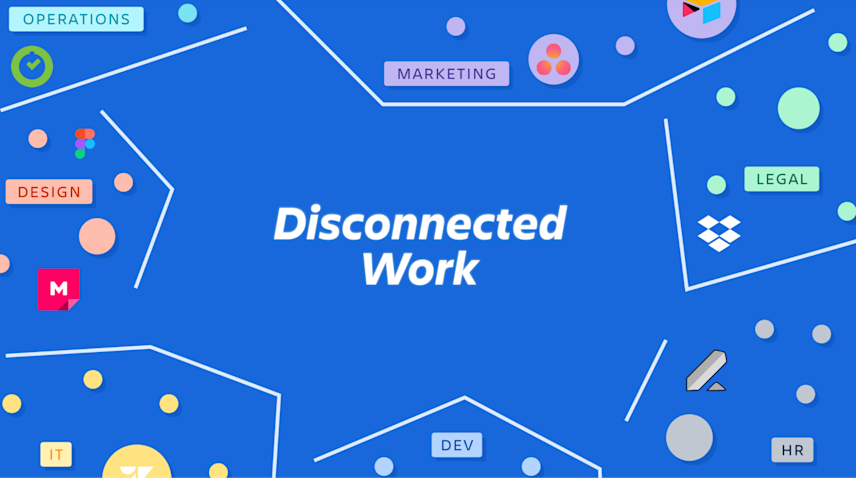
Breville’s previously disconnected tools and teams
Because of this proliferation of siloed tools and information, efficiency suffered, responsibilities and dependencies were not as clear as they could be, and employees didn’t have enough visibility to make the most informed decisions.
To solve these challenges and accelerate new product development, Breville began digitally transforming and expanding their use of Atlassian tools for both technical and non-technical teams. In close collaboration with their Advisory Services partners at Atlassian, led by Senior Enterprise Solution Strategist Deepthi Aynumpudi, Breville introduced more teams to Jira for product and project management, while adding several tools to create a connected system of work: Jira Service Management for IT and enterprise service management; Confluence for knowledge management; Bitbucket for source code collaboration; and Jira Product Discovery for one team’s product roadmapping and prioritization.
Centralizing on Jira and Confluence boosts collaboration and visibility
Deepthi and her Advisory Services colleagues were deeply invested in understanding Breville’s unique business problems and helping them develop the right solutions. For the Marketing Operations Team, which manages Breville’s global marketing efforts, the priority was centralizing cross-functional teams and information so they could collaborate more and streamline delivery.
After seeing Breville’s tech teams use Jira for years, Marketing Operations realized the tool could meet their requirements too. Even better, reduce costs. “We did a very quick cost comparison and realized Jira and Confluence were less than half of what Monday.com was,” Deepthi says.
Now we’re all using Atlassian tools, capturing all the information we need from the beginning, and creating dashboards that pull everything together in one place. It’s been a huge breakthrough.
Karla Henderson
Head of Global GTM Operations
Bringing teams together with Atlassian tools: “It’s been a huge breakthrough”
With Advisory Services’ guidance, Marketing Operations set up Jira workflows to streamline and standardize the process of marketing products on a global and regional level.
Before, creating promotions for various products and regions around the world required regional teams to fill out three forms, which went to three separate teams. The forms were often incomplete, and there was no visibility across teams.
Head of Global GTM Operations Karla Henderson says moving this process to Jira has helped with “centralizing, visibility, and bringing teams together.” Now, requestors fill out a creative brief form in Jira Service Management, and projects can be sent to Global Marketing when approvals are needed. If the project is scheduled for a date far in the future, automated reminders alert requestors as the start date approaches and ask for additional information.
After Global Marketing approves the project for kickoff, Atlassian Automation adds a series of tasks in Jira based on the deliverables requested and assigns those tasks to the relevant teams. Now, team members can easily track promotion projects by region, type, team, and even individual SKUs.
“Before, there was a disconnect because we were all using different tools. And people weren’t including all the details upfront that we needed to fulfill their request, so there was a lot of wasted time spent going back and forth,” Karla says. “Now we’re all using Atlassian tools, capturing all the information we need from the beginning, and creating dashboards that pull everything together in one place."
As Breville’s marketing teams got comfortable with their new tools, they started exploring additional ways to save even more time and add transparency for stakeholders. For example, Marketing Operations previously used Sharepoint with Power Apps to manage their product launch calendar. Now with Confluence databases, the launch calendar updates automatically based on information from Jira.
Jira Service Management: a new way to improve service while scaling
Just like the marketing organization, Breville’s IT teams have been going through their own exponential growth and digital transformation. Within a few years, IT had expanded from 30 to 230 people, and the entire company grew by 3x from 400 to 1,200 employees. To complicate matters, all employees were admins of all tools Breville used. Having so many tools and not enough standards was significantly hindering visibility and reporting.
Global Service Delivery Manager Roni Nestorovski and his team set out to solve these challenges so they could help drive innovation, growth, and service improvements. Their first priorities: centralize on one platform, and streamline ITSM practices.
Other teams were already enjoying the flexibility and tight integrations of Jira and Jira Service Management. Since the products were already familiar and fit IT’s requirements, Roni’s team chose to switch from ManageEngine and unify on one system of work with Atlassian cloud.
With help from Solution Partner Elite IT, Breville stood up their first official service desk in six weeks, then consolidated other ad-hoc services desks that had previously been created. “In no time, we had a single point of contact for all support across Breville,” Roni recalls.
Over time, IT used Jira Service Management to build out Breville’s service, incident, problem, and change management practices. Since Jira Service Management is seamlessly integrated with Jira, IT can work closely with development and operations teams (who use varying project management styles) from initial report to resolution.
"The advantage of our Breville Service Desk setup is that an incident that’s visible in Breville Service Desk, once assigned to a dev team, will appear in their project or board,” Roni says. “For example, a Scrum Master can see a logged incident and prioritize the fix on the kanban board for their scrum team. They can also link that incident to an epic that may be raised to fix the root cause.”
We did a very quick cost comparison and realized Jira and Confluence were less than half of what Monday.com was.
Deepthi Aynumpudi
Atlassian Senior Enterprise Solution Strategist
75,000+ requests with nearly perfect satisfaction scores – all in one solution
As Breville’s business teams interacted with IT, product, and development teams, they saw opportunities to use Jira Service Management in their own departments. More than 30 teams now use the Breville Service Desk, and IT worked with six more departments to set up service desks so they can manage everything from HR questions and feedback, to procurement price approvals, to marketing requests and more.
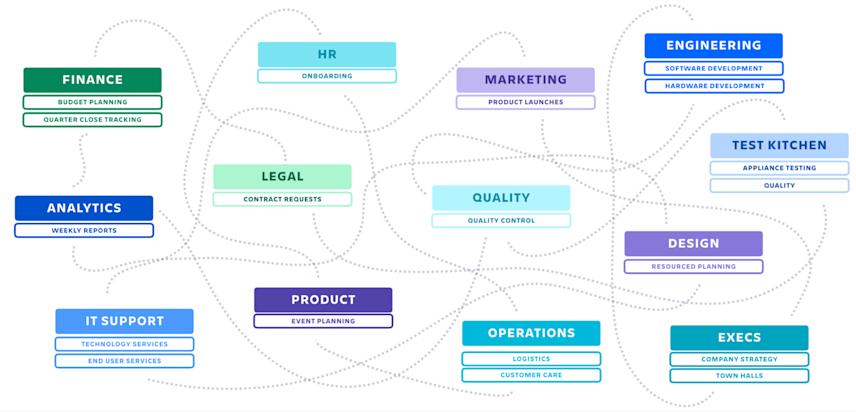
Some of the teams using Breville’s Atlassian platform
Together, these teams now manage more than 75,000 tickets every year using Jira Service Management, with an average customer satisfaction score of 4.9 out of 5. Consolidated dashboards make it easy to track key metrics (such as response times, resolution times, and closure rates) and brew up more informed, data-driven decisions.
“Freedom within a framework”: striking the balance between standardization and innovation
With help from Atlassian’s Advisory Services, Breville not only set up a shared platform, but also shared ways of working – all without losing the autonomy that drives innovation.
“Standardization provides leaders with a clear, bird’s-eye view of the business. However, when you tip too far toward control and standardization, you run the risk of stifling innovation,” Deepthi explains. “Alternatively, one can give teams the freedom to work in ways they want to work, fostering a happy and high performing workplace. However, it’s hard to get everyone aligned around a common goal and harder still to get a clear picture of progress and resources. We understood we had to find a sweet spot on the spectrum to achieve optimal outcomes. We call it ‘freedom within a framework.’”
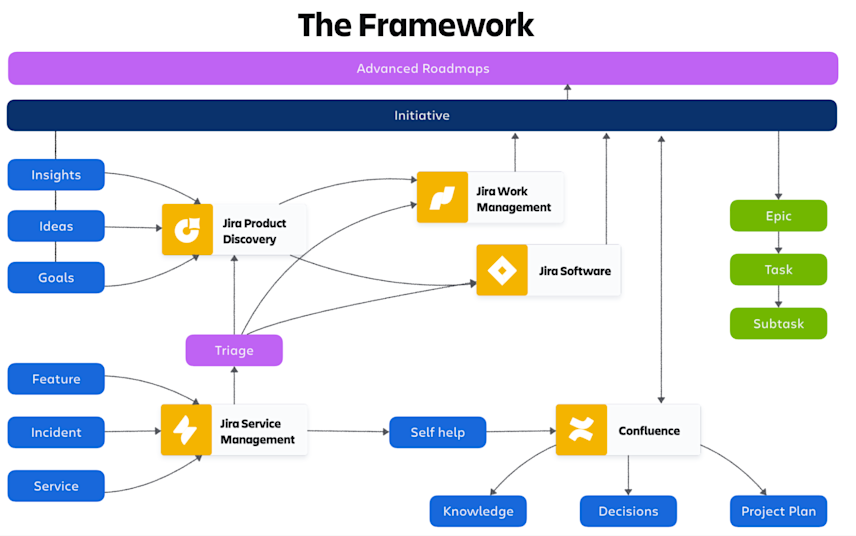
Breville’s technology framework, balancing freedom with standardization
Breville now provides this standardized framework, from which each team can pick the parts that are most important to them and choose the way they work.
For example, Breville’s Test Kitchen, which collaborates with several other teams on recipe creation and testing, had been using monday.com to manage projects and was hesitant to change. After trying Jira, the leader of the Test Kitchen became one of the tools biggest champions at Breville.
Karla says, “The head of our Test Kitchen has become a real advocate for Jira. Seeing people who weren’t interested, and those who aren’t as tech savvy, become passionate users makes it all feel worthwhile.”
Similarly, one of Breville’s product teams is using an integrated solution with Jira Product Discovery for capturing, prioritizing, and roadmapping new ideas; Jira to collaborate with development and marketing teams; Jira Service Management to log feature, service, and incident requests; and Confluence to store specs, key decisions, and other knowledge. All work is connected to top-level epics, which ladder up to business initiatives for visualization, planning, and tracking through Jira Plans.
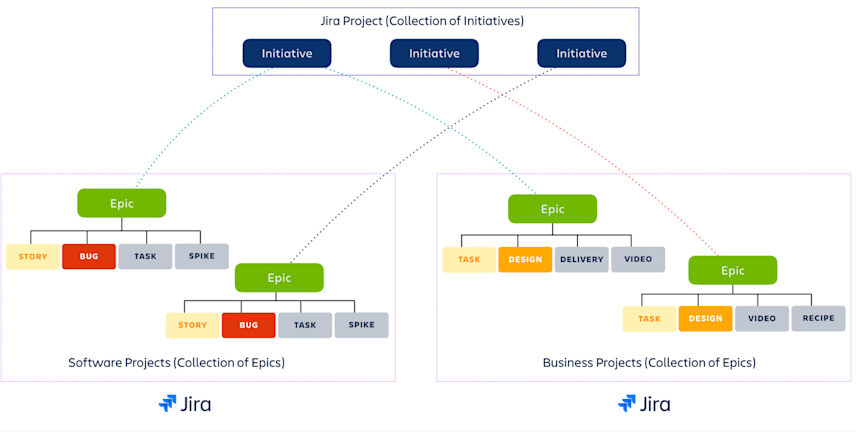
Connecting all work to high-level initiatives with Jira Plans
By having “freedom within a framework” and a unified Atlassian ecosystem, the Test Kitchen, product teams, and groups across the company are seeing improvements in cross-functional collaboration, visibility, and user satisfaction.
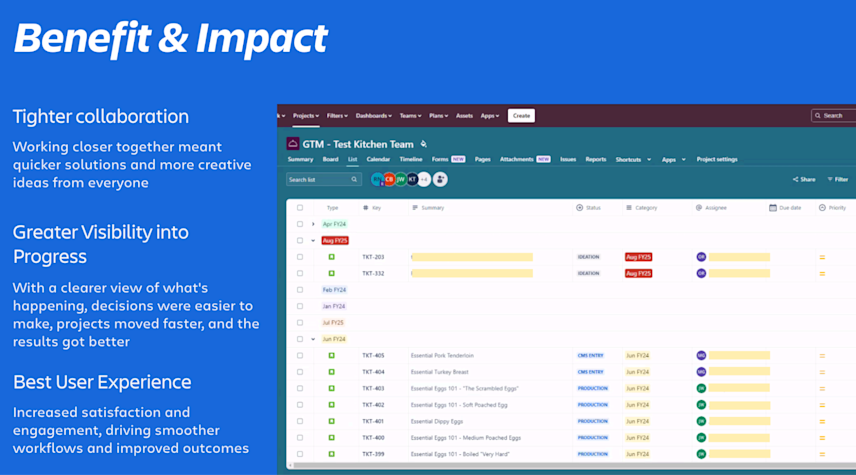
Benefit and Impact
“Teams don’t need to switch between tools or boards to find what they need. Now they have time to innovate rather than jumping to multiple meetings to share project updates,” Deepthi says. “As most of the work is connected back to overarching initiatives, we are able to track progress in Jira Plans, plan ahead, and keep an eye on dependencies so nothing falls through the cracks.”
Caffeinating collaboration with a connected system of work
Scaling so quickly can be intimidating for even the most experienced professionals. But with the right people, processes, and platform, Breville feels confident they have the right recipe to turn short-term growth into long-lasting success.
“At a fundamental level, this is all about working more efficiently,” Karla says. “Our goal in creating a central source of truth and improving collaboration across the company with one platform is to accelerate all of our business priorities and objectives.”
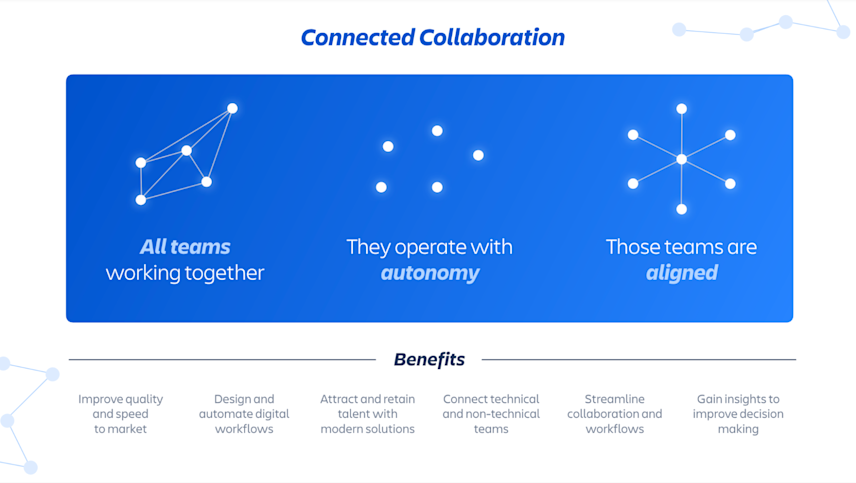
Connected collaboration and its benefits
Deepthi is proud of the progress she’s seen Breville make, and feels confident their new platforms and processes have refined their recipe for success. “To strike the balance of moving fast and together, Breville built a connected workplace where all teams are working together, teams have the autonomy to operate and innovate in the ways that work best for them, and everyone is aligned toward a common mission,” she says. “That means everything in the kitchen is cooked to perfection.”
About Breville
Breville is an iconic, global brand that enhances people’s lives through thoughtful design and brilliant innovation, delivering kitchen products to more than 70 countries around the globe. The company's advancements and insights empower people’s potential to do things more impressively or easily than they’d thought possible in their own kitchen.
Industry
Consumer Goods & Retail
Number of users
800
Location
Asia Pacific
Solution Partner
Check these out

